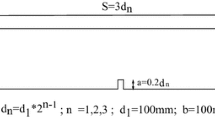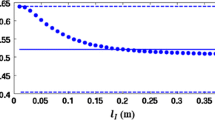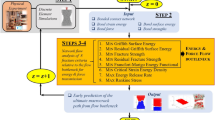Abstract
The nominal fracture energy of concrete structures is constant for relatively large structures, whereas it increases with size for relatively small structures. If the energy dissipation space is modeled as a monofractal domain, with a non-integer dimension comprised between 2 and 3, a unique slope in the bilogarithmic fracture energy versus size diagram is found, as was stated in a previous paper [1]. On the other hand, when the scale range extends over more than one order of magnitude, a continuous transition from slope+1/2 to zero slope may appear, according to the hypothesis of multifractality of the fracture surface [1]. This means that, at small scales, a Brownian microscopic disorder is prevalent whereas, at large scales, the effect of disorder vanishes, yielding a macroscopical homogeneous behavior. The dimensional transition from disorder to order may be synthesized by a Multifractal Scaling Law (MFSL) valid for toughness, in perfect correspondence with the MFSL valid for strength, which has been described in a previous paper [2]. The MFSL for fracture energy is applied, as a bestfitting method, to relevant experimental results in the literature, allowing for the extrapolation of fracture energy values valid for real-sized structures.
Résumé
L'énergie de fracture nominale des structures en béton est constante pour des structures relativement grandes, alors qu'elle augmente avec les dimensions pour les structures relativement petites. Si l'espace de dissipation de l'énergie est modelé comme domaine monofractal avec une dimension non-intégrale comprise entre deux et trois, on observe une seule pente dans le diagramme bilogarithmique énergie de fracture-dimensions, comme il a déjà été observé dans un article précédent [1]. D'autre part, si l'intervalle d'échelle s'étend à plus d'un ordre de grandeur, une transition continue de la pente +1/2 à la pente zéro peut apparaître, en accord avec l'hypothèse de multifractalité de la surface de fracture [1]. Cela montre qu'un désordre microscopique Brownien prédomine dans les petites échelles, alors que, dans les grandes, l'effet de désordre disparaît et donne lieu à un comportement macroscopique homogène. La transition dimensionnelle du désordre à l'ordre peut être syntheétisée par la Loi d'Échelle Multifractale (MFSL) valable pour la ténacité, en parfait accord avec la Loi d'Échelle Multifractale valable pour la résistance, qui a été décrite dans un article précédent [2]. La Loi d'Échelle Multifractale pour l'énergie de fracture est appliquée, comme méthode d'interpolation «best-fitting», aux résultats d'expérimentation plus importants contenus dans la littérature, car elle permet d'extrapoler les valeurs de l'énergie de fracture valables pour les structures de dimensions réelles.
Similar content being viewed by others
References
Carpinteri, A. and Chiaia, B., ‘Multifractal nature of concrete fracture surfaces and size effects on nominal fracture energy’,Materials and Structures,28 (182) (1995) 435–443.
Carpinteri, A., Chiaia, B. and Ferro, G., ‘Size effects on nominal tensile strength of concrete structures: multifractality of material ligaments and dimensional transition from order to disorder’,Materials and Structures,28 (180) (1995) 311–317.
Hillerborg, A., Modeer, M. and Petersson, P.E., ‘Analysis of crack formation and crack growth in concrete by means of fracture mechanics and finite elements’,Cement and Concrete Research,6 (1976) 773–782.
RILEM Technical Committee 50, ‘Determination of the fracture energy of mortar and concrete by means of three-point bend tests on notched beams’, Draft Recommendation,Materials and Structures,18 (1985) 287–290.
Hillerborg, A., ‘Results of three comparative test series for determining the fracture energyG F of concrete’,Materials and Structures,18 (1985) 407–413.
Swartz, S.E. and Refai, T.M.E., ‘Influence of size effects on opening mode fracture parameters for precracked concrete beams in bending’, Proceedings of the SEM/RILEM Int. Conf. Fracture of Concrete and Rock (Shah and Swartz eds., Houston, 1987), pp. 403–417.
Wittmann, F.H., Mihashi, H. and Nomura, N., ‘Size effect on fracture energy of concrete’,Engineering Fracture Mechanics,35 (1990) 107–115.
Hu, X.Z. and Wittmann, F.H., ‘Fracture energy and fracture process zone’,Materials and Structures,25 (1992) 319–326.
Mai, Y.W. and Cotterell, B., ‘Effect of specimen geometry on the essential work of plane stress ductile fracture’,Engineering Fracture Mechanics,21 (1985) 123–128.
Guinea, G.V., Planas, J. and Elices, M., ‘Measurement of the fracture energy using three-point bend tests: Part 1-Influence of experimental procedures’,Materials and Structures,25 (1992) 212–218.
Planas, J., Elices, M. and Guinea, G.V., ‘Measurement of the fracture energy using three-point bend tests: Part 2-Influence of bulk energy dissipation’,Materials and Structures,25 (1992) 305–312.
Elices, M., Guinea, G.V. and Planas, J., ‘Measurement of the fracture energy using three-point bend tests: Part 3-Influence of cutting theP-δ tail’,Materials and Structures,25 (1992) 327–334.
Bažant, Ž.P. and Kazemi, M.T., ‘Size dependence of concrete fracture energy determined by the RILEM work-of-fracture method’,Int. Jour. Fracture,51 (1991) 121–138.
Bažant, Ž.P., ‘Size effect in blunt fracture: concrete, rock, metal’,Journal of Engineering Mechanics, ASCE,110 (1984) 518–535.
Karihaloo, B.L. and Nallathambi, P., ‘Size-effect prediction from effective crack model for plain concrete’,Materials and Structures,23 (1990) 178–185.
Jenq, Y. and Shah, S.P., ‘Two-parameter fracture model for concrete’,Jour. Eng. Mech., ASCE,111 (1985) 1227–1241.
Carpinteri, A., ‘Scaling laws and renormalization groups for strength and toughness of disordered materials’,International Journal of Solids and Structures 31 (1994) 291–302.
Carpinteri, A., ‘Fractal nature of material microstructure and size effects on apparent mechanical properties’,Mechanics of Materials,18 (1994) 89–101.
Bosco, C. and Iori, I., ‘Sulla meccanica della frattura dei laterizi: indagine sperimentale di elementi inflessi ed analisi di parametri caratteristici’,Studi e Ricerche,13 (1992) 269–300.
Marquardt, D.W., ‘An algorithm for least-squares estimation of nonlinear parameters’,Jour. Soc. Industr. Appl. Math.,11 (1963) 431–441.
Perdikaris, P.C. and Romeo, A., ‘Effect of size and compressive strength on the fracture energy of plain concrete’, Proceedings of the First International Conference on Fracture Mechanics of Concrete Structures, FRAMCOS1, (Bažant ed., Breckenridge, 1992) pp. 550–555.
Carpinteri, A., ‘Mechanical Damage and Crack Growth in Concrete: Plastic Collapse to Brittle Fracture’, (Martinus Nijhoff Publishers, Dordrecht, 1986).
Carpinteri, A. and Ferro, G., ‘Size effects on tensile fracture properties: a unified explanation based on disorder and fractality of concrete microstructure’,Materials and Structures,27 (1994) 563–571.
Author information
Authors and Affiliations
Additional information
Editorial note Prof. Alberto Carpinteri and Dr. Bernardino Chiaia are both working at the Politecnico di Torino, a RILEM Titular Member. Prof. Carpinteri is involved in the work of RILEM Technical Commirrees 147-FMB on Fracture Mechanics applications to anchorage and Bond and 148-SSC on Tests methods for the Strain Softening response on Concrete. In 1982, Prof. Alberto Carpinteri was awarded the Robert L'Hermite Medal for his outstanding research work.
Rights and permissions
About this article
Cite this article
Carpinteri, A., Chiaia, B. Size effects on concrete fracture energy: dimensional transition from order to disorder. Mat. Struct. 29, 259–266 (1996). https://doi.org/10.1007/BF02486360
Issue Date:
DOI: https://doi.org/10.1007/BF02486360




